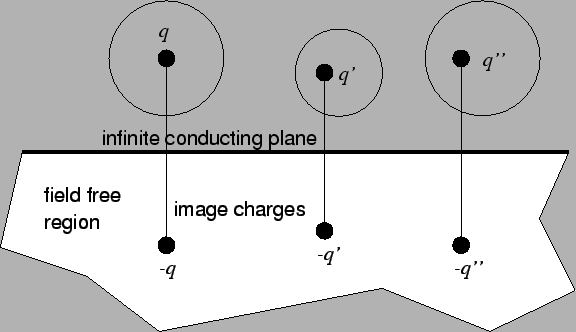



Next: B Fermi Energy Dependence
Up: A Capacitance Calculations
Previous: A.3 Capacitance of Two
It is possible with the same method, as was used before for calculating the
capacitance of two spheres, to calculate the capacitance of an arbitrary
arrangement of not intersecting conducting spheres with different diameters
and an optional infinite conducting plane.
One starts with a charge on the sphere for which the total capacitance is to
be obtained. Then compensation charges are placed in all other spheres,
so that these spheres stay zero equipotential surfaces. In case
an infinite conducting plane is present, all charges so far calculated have
to be mirrored on this plane to make it a zero equipotential (see
Fig. A.5).
Figure A.5:
In order to make the infinite plane a zero equipotential, all
charges have to be mirrored.
 |
But every
placed compensation charge will disturb the before compensated potentials.
Hence, the compensation charges have to be recursively compensated themselves.
For more than two conductors the number of compensation charges grows
exponentially for every level
of recursion. For N spheres the number of charges progresses as

In order to assure convergence of the successive approximation the magnitudes
of compensation charges have to decrease sufficiently. A sufficient but not
mandatory condition that the sum of compensation charges which are added with
each level of recursion vanishes is
 ,
where again a is the radius and d the center to center distance of
spheres.
For spheres with equal diameters the ratio a/d is less than 1/2, which
assures that the algorithm always converges for two and three spheres.
In the case of more spheres usually not all spheres will be close to each
other, which means that the ratio a/d is in average much smaller than
1/2, and hence the algorithm converges for arrangements with more
conductors. For example, lines of an arbitrary number of spheres are
successfully calculated. The results are shown in Table A.2.
However if too many spheres are placed too closely together the algorithm does
not converge. No simple convergence criteria exists. A possibility to
detect lack of convergence is to monitor the sum of added compensation charges.
If the sum grows with each iteration the algorithm will not converge.
,
where again a is the radius and d the center to center distance of
spheres.
For spheres with equal diameters the ratio a/d is less than 1/2, which
assures that the algorithm always converges for two and three spheres.
In the case of more spheres usually not all spheres will be close to each
other, which means that the ratio a/d is in average much smaller than
1/2, and hence the algorithm converges for arrangements with more
conductors. For example, lines of an arbitrary number of spheres are
successfully calculated. The results are shown in Table A.2.
However if too many spheres are placed too closely together the algorithm does
not converge. No simple convergence criteria exists. A possibility to
detect lack of convergence is to monitor the sum of added compensation charges.
If the sum grows with each iteration the algorithm will not converge.
Table:
Capacitances of spheres aligned in a line.
 is the
total capacitance of the center sphere which has the number 1, C10 is
its self-capacitance and the C1i are the capacitances between the
center sphere and spheres next in line. All spheres have a
diameter of 2 nm and a distance from surface to surface of 1 nm to their
neighbors. The surrounding medium has
is the
total capacitance of the center sphere which has the number 1, C10 is
its self-capacitance and the C1i are the capacitances between the
center sphere and spheres next in line. All spheres have a
diameter of 2 nm and a distance from surface to surface of 1 nm to their
neighbors. The surrounding medium has
 .
All capacitances
are given in aF.
.
All capacitances
are given in aF.
| sphere arrangement |
 | C10 | C12 | C13 |
 | 0.111 | 0.111 | | |
 | 0.128 | 0.0843 | 0.0433 | |
 | 0.142 | 0.0612 | 0.0403 | |
 | 0.143 | 0.0520 | 0.0375 | 0.00788 |
|




Next: B Fermi Energy Dependence
Up: A Capacitance Calculations
Previous: A.3 Capacitance of Two
Christoph Wasshuber

